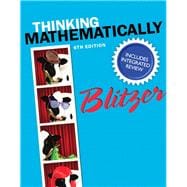ALERT: Before you purchase, check with your instructor or review your course syllabus to ensure that you select the correct ISBN. Several versions of Pearson's MyLab & Mastering products exist for each title, including customized versions for individual schools, and registrations are not transferable. In addition, you may need a CourseID, provided by your instructor, to register for and use Pearson's MyLab & Mastering products.
Packages
Access codes for Pearson's MyLab & Mastering products may not be included when purchasing or renting from companies other than Pearson; check with the seller before completing your purchase.
Used or rental books
If you rent or purchase a used book with an access code, the access code may have been redeemed previously and you may have to purchase a new access code.
Access codes
Access codes that are purchased from sellers other than Pearson carry a higher risk of being either the wrong ISBN or a previously redeemed code. Check with the seller prior to purchase.
--
Blitzer’s Thinking Mathematically with Integrated Review is a co-requisite course solution, offering a complete liberal arts mathematics MyMathLab® course with integrated review of select topics from developmental algebra. This course solution may be used in a co-requisite course model, or simply to help under-prepared students master prerequisite skills and concepts.
About Blitzer’s Thinking Mathematically:
For courses in liberal arts mathematics
In Thinking Mathematically, Sixth Edition, Bob Blitzer’s distinctive and relatable voice motivates students from diverse backgrounds and majors, engaging them in the math through compelling, real-world applications. Understanding that most students in a liberal arts math course are not math majors, and are unlikely to take another math class, Blitzer has provided tools in every chapter to help them master the material with confidence, while also showing them the beauty and fun of math. The variety of topics and flexibility of sequence make this text appropriate for a one- or two-term course in liberal arts mathematics or general education mathematics.
0321986342 / 9780321986344 Thinking Mathematically with Integrated Review and Worksheets plus NEW MyMathLab with Pearson eText -- Access Card Package
Package consists of:
0321262522 / 9780321262523 MyMathLab -- Valuepack Access Card
0321867327 / 9780321867322 Thinking Mathematically
0321986407 / 9780321986405 Worksheets for Thinking Mathematically with Integrated Review









